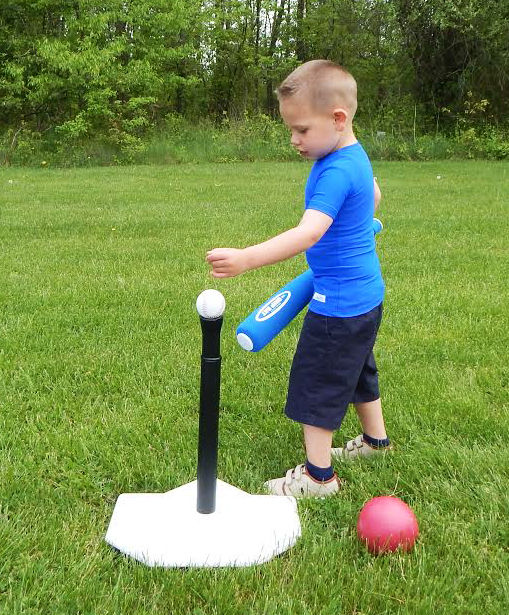Sometimes children can feel left out or withdraw if they haven’t mastered the skills to play team sports. Skills like agility, balance, timing, eye hand coordination, visual acuity are important in games like T-ball, whiffle ball, and kickball.
You can adapt a traditional game like T-ball or Kickball to different levels if you have a group of children with various abilities. Many children can benefit from breaking down the skills needed to play and by making a few rule adaptations. Make sure to keep the activity or sport fun, engaging and successful for the children no matter how small the step they achieve. If they feel encouraged, they will want to continue to play the game.
Let’s play!
T-ball

You may need to make a few additional steps for a child with different abilities to play
T-ball. Have at least one or two adults in the field to help the children navigate this adapted game.
Bats:
If a child has trouble with batting, try using a bat that is larger in diameter or lighter. You can even try making a homemade bat. If using any bat is too difficult for the child, have the child push the ball off the tee with both hands or have the child grasp their hands together, use the correct stance, rotate the body to hit the ball off the tee with clasped hands. You can also let the child throw the ball from home plate.
Visuals:
Place a visual or marker on the ground (such as footprints) to help the child know where to stand or where to place each foot when batting.
Ball:
Vary the ball color, size, and weight. You may need to use a larger or lighter rubber ball to help the child with visual or motor skill challenges. If you need to bring the outfield in even closer, try using a 12” beach ball (a beach ball will not travel as far).
Catching the Ball (Fielding):
If you use a Velcro tennis ball on the T-Stand, you can use Velcro mitts to catch the ball. If using larger balls have the child field the ball and either throw or roll to the base.
If the children playing have significant difficulty motor planning and executing the fielding of the ball and then throwing, allow the child to pick up and run to an indicated base (put bright colored bases in the field). If the distance to travel is too far for a child, lessen the distance between bases in the field or use a smaller number of bases.
Kickball
The game of Kickball requires a few skills:
A ball needs to be rolled straight toward home plate to set up the kick
Kicker must use sensory motor skills, visual skills and timing to kick the ball at the right time
Child must run towards first base
Outfielders must catch or pick up (field) the ball
Throwing either at the runner or to the defense first base player
Tagging the runner
These are a few ideas to adapt the kickball game to include all players:
Adults or older children on the field can give verbal and physical prompts by partnering with the kicker at bat during the kick and then run to base with them. Have the parent or instructor be the pitcher (roller of the ball). This way they can adjust the distance and the rate of the roll. If a child is unable to successfully kick a rolling ball and needs additional kicking practice, when the child is not in play, place the ball on a marker and practice kicking a stationary ball, then a very short distance rolling ball. When that child is up to bat it may be best for success and self-esteem to have that child only kick a stationary ball. Try using a different ball size, this will affect how the ball rolls as well as the ability to kick. It may also help to use a brightly colored ball to increase visual attention. Depending on the children’s collective levels, you can simplify the game rules, such as, each child gets one up and goes toward only one base at a time. After each child has had a turn, the next team is up. This will also alleviate the chance that one team will be up for a long time and the other not.
When fielding the ball, instead of throwing to the base or at the runner you can throw to or run the ball to the parent who is pitcher which halts the action.
Practicing other gross motor skills:
You can also use this team game to practice skills and just make plain old fun for the children, not competition. For instance, ask the child to perform another skill when moving from first to second base such as practicing agility, rhythm, skipping, shuffling, wheelbarrow walking, or jumping in and out of Hula Hoops. When moving to the next base change the sensory skill such as working on balance. Have the child walk along a taped or chalked line from one base to another, walk a low balance beam, or walk on an uneven surface that has been set up. Keep note, depending on the child’s ability level, you may want to reduce the distance between bases in the field or lessen the number of bases. Don’t forget to use base markers that are colorful and fun!
By making a few simple adaptations to T-ball and Kickball, children of all different abilities will be able to play together this summer. Not only will children enjoy playing these favorite pastimes with their peers, they will also have the opportunity to practice gross motor skills beyond the regular rules of the game.
Author bio: Elizabeth Duhan serves as the Marketing Project Specialist at Applied Medical Technology, Inc. — a global leader and manufacturer of enteral feeding devices and accessories, upholding the highest standard for performance and quality assurance for over 30 years.
